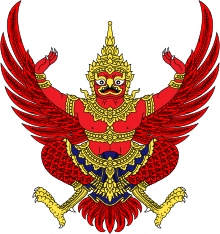Hospitals in Thailand
Hospitals in Thailand are operated by both the public and private sector, to provide medical services for prevention, cure and rehabilitation of patients with medical and health-related conditions. The majority are operated by the Ministry of Public Health (MOPH). Private hospitals are regulated by the Medical Registration Division under the MOPH's Department of Health Service Support following the Sanatorium Act, B.E. 2541. Other government units and public organisations also operate hospitals, including the military, universities, local governments and the Red Cross. As of 2010, there are 1,002 public hospitals and 316 registered private hospitals. The full listing of hospitals can be accessed at List of hospitals in Thailand.
Public hospitals
Most public (i.e., state-owned) hospitals fall under the authority of the Ministry of Public Health. The majority of these are provincial hospitals under the aegis of the Office of the Permanent Secretary of the MOPH. Others are operated by the Department of Medical Services, Department of Mental Health, Department of Health, and Department of Disease Control. Certain non-MOPH state agencies also operate hospitals.
Office of the Permanent Secretary
As of 2018, there are a total of 895 hospitals under the Office of the Permanent Secretary are classified as follows:[1][2]
Regional hospitals
Regional hospitals (Thai: โรงพยาบาลศูนย์) are found in provincial centres, have a capacity of at least 500 beds and have a comprehensive set of specialists on staff. These hospitals are capable of tertiary care and are under the category A (advanced) service level in the MOPH's service plan.[3] As of 2018, there are a total of 34 regional hospitals in Thailand.[1]
General hospitals
General hospitals (Thai: โรงพยาบาลทั่วไป) are located in province capitals or major districts and have a capacity of 200 to 500 beds. These hospitals are capable of secondary care and are under the category S and M1 service level[3]. As of 2018, there are total of 85 general hospitals in Thailand.[1]
Community hospitals
Community hospitals (Thai: โรงพยาบาลชุมชน) are located in the district level and are usually limited to providing primary care treatment and are under the category M2, F1, F2 and F3 service level[3]. These will refer patients in need of more advanced or specialised care to general or regional hospitals. As of 2018, there are a total of 776 community hospitals in Thailand.[1] Some community hospitals are capable of secondary care. They are further classified by size listed below:
- Large community hospitals have a capacity of 90 to 150 beds.
- Medium community hospitals have a capacity of 60 beds.
- Small community hospitals have a capacity of 10 to 30 beds.
Crown Prince Hospitals (Somdet Phra Yuppharat Hospitals)
Crown Prince hospitals (Thai: โรงพยาบาลสมเด็จพระยุพราช) are community hospitals (except Sa Kaeo, Sawang Daen Din and Det Udom which are general hospitals) with a capacity of 30 to 200 beds, all with capabilities of primary care and some providing secondary care. These hospitals are operated by the Crown Prince Hospital Foundation. Construction of 20 Crown Prince hospitals was initiated in 1977, during the prime ministership of Thanin Kraivichien, to provide medical services at distant locations throughout the country and as a present for King Vajiralongkorn's (then Crown Prince) royal marriage on 3 January 1977. There are 21 Crown Prince hospitals in Thailand:
- Northern Region
- Chiang Khong Crown Prince Hospital, Chiang Khong District, Chiang Rai Province
- Taphan Hin Crown Prince Hospital, Taphan Hin District, Phichit Province
- Pua Crown Prince Hospital, Pua District, Nan Province
- Nakhon Thai Crown Prince Hospital, Nakhon Thai District, Phitsanulok Province
- Lom Kao Crown Prince Hospital, Lom Kao District, Phetchabun Province
- Den Chai Crown Prince Hospital, Den Chai District, Phrae Province
- Northeastern Region
- Det Udom Crown Prince Hospital, Det Udom District, Ubon Ratchathani Province
- Tha Bo Crown Prince Hospital, Tha Bo District, Nong Khai Province
- Kranuan Crown Prince Hospital, Kranuan District, Khon Kaen Province
- Ban Dung Crown Prince Hospital, Ban Dung District, Udon Thani Province
- Kuchinarai Crown Prince Hospital, Kuchinarai District, Kalasin Province
- That Phanom Crown Prince Hospital, That Phanom District, Nakhon Phanom Province
- Sawang Daen Din Crown Prince Hospital, Sawang Daen Din District, Sakon Nakhon Province
- Loeng Nok Tha Crown Prince Hospital, Loeng Nok Tha District, Yasothon Province
- Dan Sai Crown Prince Hospital, Dan Sai District, Loei Province
- Eastern Region
- Sa Kaeo Crown Prince Hospital, Mueang Sa Kaeo District, Sa Kaeo Province
- Central Region
- Chom Bueng Crown Prince Hospital, Chom Bueng District, Ratchaburi Province
- Southern Region
- Chawang Crown Prince Hospital, Chawang District, Nakhon Si Thammarat Province
- Sai Buri Crown Prince Hospital, Sai Buri District, Pattani Province
- Wiang Sa Crown Prince Hospital, Wiang Sa District, Surat Thani, Surat Thani Province
- Yaha Crown Prince Hospital, Yaha District, Yala Province
Sub-district Health Promoting Hospitals
Sub-district Health Promoting Hospitals (Thai: โรงพยาบาลส่งเสริมสุขภาพตำบล) are hospitals that are operated by either the MOPH or Department of Local Administration and were initially called "health stations" (Thai: สถานีอนามัย). These hospitals only have primary care capabilities and often serve villages within districts. Almost all of these hospitals do not accept inpatients and usually have no doctor on duty for the entire time. Such hospitals therefore will have medical staff entering irregularly from the community hospital within that district. In 2009, Abhisit Vejjajiva's cabinet approved a policy to improve the quality of healthcare services provided at health stations throughout Thailand and funding was allocated into the Thai Khem Khaeng programme to upgrade existing health stations to sub-district health promoting hospitals and improve quality of care.
Other departments
The Department of Medical Services (DMS) operates several public central hospitals in Bangkok, including Rajavithi Hospital and Lerdsin Hospital.[4] It is also responsible for all specialised hospitals, both inside and outside Bangkok, such as the National Cancer Institute, Prasat Neurological Institute, the Queen Sirikit National Institute of Child Health. This is with some exceptions of public specialised hospitals in the field of psychiatry where all hospitals are under the responsibility of the Department of Mental Health (DMH), such as the Somdet Chaopraya Institute of Psychiatry and Srithanya Hospital. Some hospitals are also managed by the Department of Disease Control (DDC), the main hospital being the Bamrasnaradura Infectious Disease Institute.[5]
Non-MOPH agencies
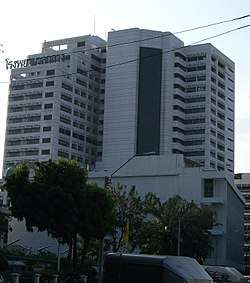
Other organisations also operate public hospitals in Thailand and citizens of Thailand can use their medical services under the Universal Coverage Scheme at no additional cost. These organisations include:
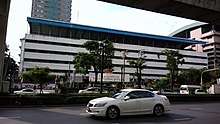
- Office of the Surgeon General, Royal Thai Police
- Ministry of Justice
- Ministry of Finance
- Bangkok Metropolitan Administration
- Department of Local Administration
- Pattaya City
- Phuket Provincial Administration
- Surat Thani Provincial Administration
- Nakhon Si Thammarat City Municipality
- Udon Thani City Municipality
- Chiang Mai City Municipality
- State Railway of Thailand
- Port Authority of Thailand
- Metropolitan Electricity Authority
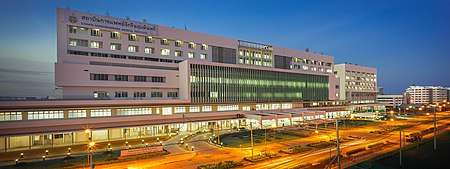
University-affiliated hospitals
This type of hospital is affiliated with faculties of medicine at universities and colleges in Thailand. Most of these hospitals are under the responsibility of the Ministry of Higher Education, Science, Research and Innovation and provide medical services at the "super tertiary care" level. These hospitals are equipped with the best resources in Thailand considering they are medical schools for teaching and research. However, in the table below, some hospitals are under the authority of the affiliated university, but are not used for medical student training, but rather only for research purposes or to provide specialised treatment; and some although used for teaching, are not operated by the affiliated university.

| Hospital Name | Affiliated University | Province |
|---|---|---|
| Siriraj Piyamaharajkarun Hospital | Faculty of Medicine Siriraj Hospital, Mahidol University | Bangkok |
| Golden Jubilee Medical Center | Faculty of Medicine Siriraj Hospital, Mahidol University | Nakhon Pathom |
| Hospital for Tropical Diseases | Faculty of Tropical Medicine, Mahidol University | Bangkok |
| Queen Sirikit Heart Center of the Northeast | Faculty of Medicine, Khon Kaen University | Khon Kaen |

CPIRD Medical Education Centers
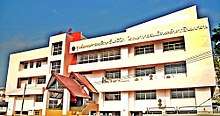
In 1994, the cabinet approved of a cooperation between the MOPH and Thai universities to organise a program known as the 'Collaborative Project to Increase Production of Rural Doctors (CPIRD)' in order to increase the number of medical personnel in rural areas of Thailand. To reach these goals, the cabinet set up the CPIRD Office in 1997 to oversee the project's activities. In terms of education, the preclinic level of study (years 1-3) will take place at the student's university or college. At the clinical level of study (years 4-6), study will take place at hospitals all around the country under the guidance of the MOPH. 'Medical Education Centers' (Thai: ศูนย์แพทยศาสตรศึกษา ชั้นคลินิก) have been established for medical students in the CPIRD program at these hospitals. There are currently 45 CPIRD Medical Education Centers in Thailand.[6]
Private hospitals
Some hospitals in Thailand are operated by the private sector by either a private limited company or a public limited company. Specialised private hospitals in the fields of ophthalmology and dentistry are common.

The term "general hospital", when referring to private hospitals, refer to hospitals which provide non-specialised care. Private hospitals with fewer than 30 beds are officially termed "health centres". Both accept patient admissions.
See also
References
- "ข้อมูลพืนฐานโรงพยาบาลในังกัดสำนักงานปลัดกระทรวงสาธารณสุข ณ สงหาคม 2561" (PDF).
- "ข้อมูลทั่วไปเกี่ยวกับสถานบริการ". Bureau of Policy and Strategy website (in Thai). Bureau of Policy and Strategy, Office of the Permanent Secretary, Ministry of Public Health. Archived from the original on 5 February 2009. Retrieved 10 November 2011.
- "เล่มแผนพัฒนาระบบบริการสุขภาพ (Service Plan) พ.ศ. 2561-2565".
- "กรมการแพทย์ กระทรวงสาธารณสุข".
- "กรมสุขภาพจิค กระทรวงสาธารณสุข".
- "CPIRD".
- This article incorporates material from the corresponding Thai article, th:โรงพยาบาลในประเทศไทย.
